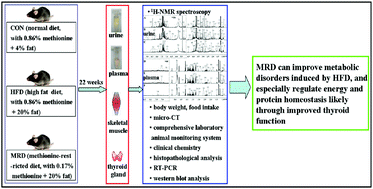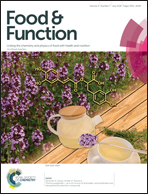Dietary methionine restriction regulated energy and protein homeostasis by improving thyroid function in high fat diet mice†
Abstract
Methionine-restricted diets (MRD) show an integrated series of beneficial health effects, including improving insulin sensitivity, limiting fat deposition, and decreasing oxidative stress, and inflammation responses. We aimed to explore the systemic responses to a MRD in mice fed with a high fat (HFD) and clarify the possible mechanism. Mice were fed with a control diet (0.86% methionine + 4% fat, CON), HFD (0.86% methionine + 20% fat), or MRD (0.17% methionine + 20% fat) for 22 consecutive weeks. HFD-fed mice showed widespread systemic metabolic disorders and thyroid dysfunction. A MRD significantly increased energy expenditure (e.g. fatty acid oxidation, glycolysis, and tricarboxylic acid cycle metabolism), regulated protein homeostasis, improved gut microbiota functions, prevented thyroid dysfunction, increased plasma thyroxine and triiodothyronine levels, decreased plasma thyroid stimulating hormone levels, increased type 2 deiodinase (DIO2) activity, and up-regulated mRNA and protein expression levels of DIO2 and thyroid hormone receptor α1 in the skeletal muscle. These results suggest that a MRD can improve the metabolic disorders induced by a HFD, and especially regulate energy and protein homeostasis likely through improved thyroid function. Thus, reducing methionine intake (e.g. through a vegan diet) may improve metabolic health in animals and humans.



 Please wait while we load your content...
Please wait while we load your content...